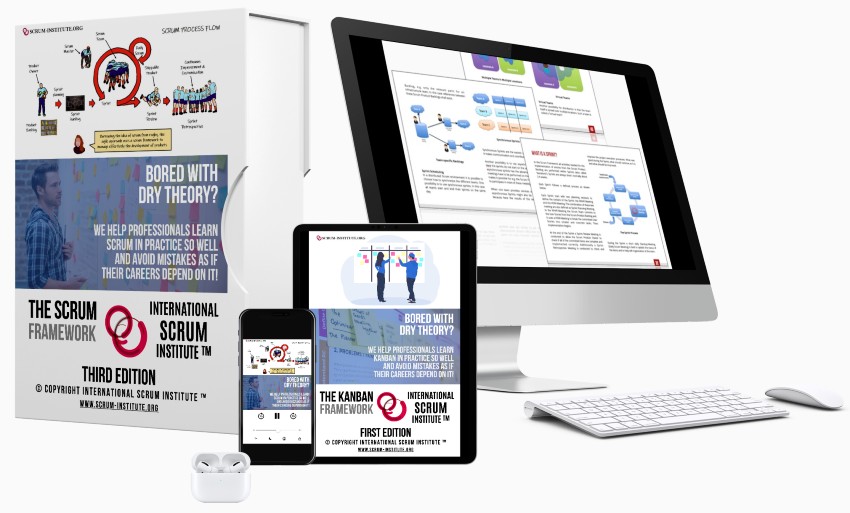What Are The Origins Of Kanban?
The three systems which historically build the origins of the Kanban framework have one significant common aspect. When it comes to production planning, they all have chosen "pull" modus operandi over “push".
What is "push" modus operandi in production planning?
With "push" modus operandi, the supply center keeps on producing and delivering parts regardless of the moment the demand center consumes them.
What is "pull" modus operandi in production planning?
With "pull" modus operandi, the supply center produces and delivers parts based on requests coming from the demand center.
A crucial element of the success with a pushbased production scheduling is the competence of the demand-forecast. So that the supply center produces and delivers parts without causing under- or over-inventory in the demand center.
Kanban, on the contrary, establishes a method where the pull comes from the demand center, and products or components are Just-In-Time (JIT) manufactured based on demand. Production, delivery, resupply, and replenishment are all determined based on actual client needs.
Although it's a challenge, done correctly, this approach optimizes the use of resources needed both in supply and demand centers, whereas it makes inventory management almost obsolete.
Now let's discuss the origins of the Kanban framework, the three processes which constructed its foundation
Kanban Two-Bin System For Shelf-Stocking
"2-bin system" stems from the most basic visual stock replenishment signaling system, an empty box. Factories in the United Kingdom initially set up this process to produce Spitfires throughout the Second World War.
Toyota analyzed processes in supermarkets during the 1940s to identify diverse shelfstocking strategies for their own factory floor
In a supermarket, consumers typically buy what they require at the needed time with the desired quantities. Furthermore, a supermarket builds its stocks for what it anticipates to sell in a given timeframe. Clients usually only buy what they require since the future supply is ensured.
This observation led Toyota to see a process as a client of several preceding processes and to see the other preceding processes as a kind of store.
Kanban utilizes the rate of demand to control the rate of production, passing requirements from the consumer up through the series of production and delivery process. In 1953, Toyota applied this mechanism in their main plant factory.
Kanban aligns stock levels with real intake. A signal informs a supplier process to produce and provide a brand-new shipment when the consumer process takes in the material. This signal is leveraged during the entire replenishment cycle to bring clarity to both the supplier and customer.
Kanban Three-Bin System For Supply Chain Management
A "3-bin system" links various departments or various parts of work processes. Sometimes, it even links business to its outside suppliers.
A typical 3-bin system should work like this: The factory places one bin where items are manufactured. The shop places another bin where parts and materials are held. And the supplier places one more bin.
When the factory has no more parts of a specific type, it sends its empty bin to the shop to be refilled. The shop fills the bin and then dispatches its own freshly emptied bin to the supplier. The supplier then sends a full bin to the store.
The bins function as the signal to indicate that downstream processes need more of some parts. They also offer permission to move parts from one place to another. In Kanban, absolutely nothing moves without a demand signal from a demand center.
The majority of 3-bin systems also keep Kanban cards (or some other information sheet) in the bins specifying what the bin includes and in what quantity. When one of these bins is leaving its original center to be refilled by another party, cards help process participants to view the role of these bins.
Toyota's Six Rules For Kanban
Toyota team has created six significant rules (Toyota’s Six Rules for Kanban) which guide Kanban practitioners from the past to today.
- Each consumer process dispatches demands (bins and Kanban cards) to its supplier processes after it consumes its materials.
- Each supplier process manufactures and delivers in association with the amount and sequence of incoming demands.
- Items are neither manufactured nor delivered without a pending demand.
- The request (Kanban card) related to an item (bin) is always connected to it.
- Supplier processes must adhere to the highest standards of quality assurance to guarantee that the delivered products are defect-free.
- Limiting the number of pending demands makes a process more delicate and reveals potential inefficiencies to be addressed.
Share It With Your Colleagues and Friends to Help Them Learn:
What Are The Origins Of Kanban?
|
|

|

|

|

|
|
 SCRUM INSTITUTE™
SCRUM INSTITUTE™





